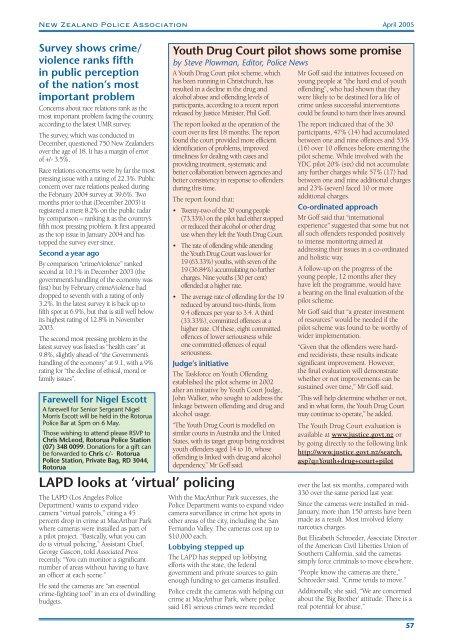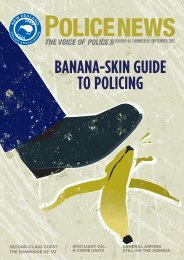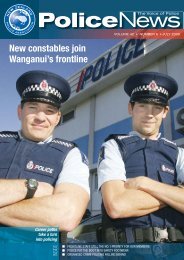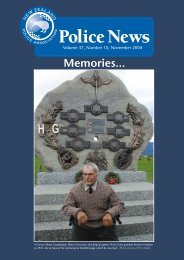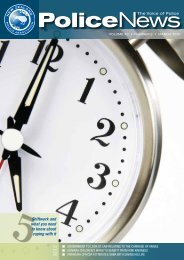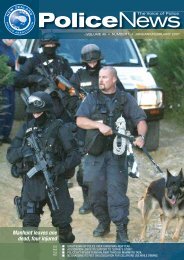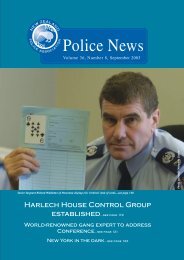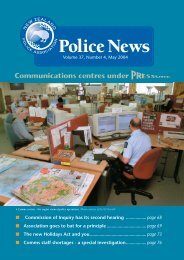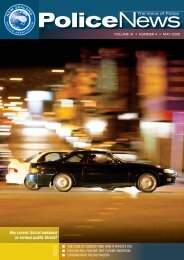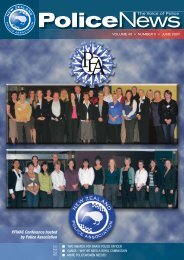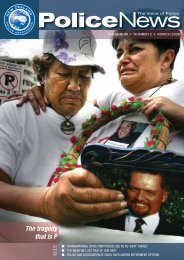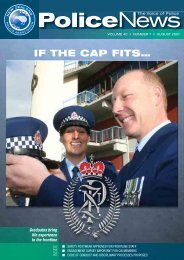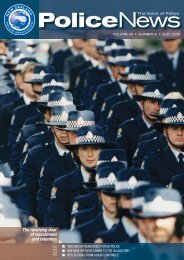Police News April 05.indd - New Zealand Police Association
Police News April 05.indd - New Zealand Police Association
Police News April 05.indd - New Zealand Police Association
Create successful ePaper yourself
Turn your PDF publications into a flip-book with our unique Google optimized e-Paper software.
<strong>New</strong> <strong>Zealand</strong> <strong>Police</strong> <strong>Association</strong><strong>April</strong> 2005Survey shows crime/violence ranks fifthin public perceptionof the nation’s mostimportant problemConcerns about race relations rank as themost important problem facing the country,according to the latest UMR survey.The survey, which was conducted inDecember, questioned 750 <strong>New</strong> <strong>Zealand</strong>ersover the age of 18. It has a margin of errorof +/- 3.5%.Race relations concerns were by far the mostpressing issue with a rating of 22.3%. Publicconcern over race relations peaked duringthe February 2004 survey at 39.6%. Twomonths prior to that (December 2003) itregistered a mere 8.2% on the public radarby comparison – ranking it as the country’sfifth most pressing problem. It first appearedas the top issue in January 2004 and hastopped the survey ever since.Second a year agoBy comparison “crime/violence” rankedsecond at 10.1% in December 2003 (thegovernment’s handling of the economy wasfirst) but by February crime/violence haddropped to seventh with a rating of only3.2%. In the latest survey it is back up tofifth spot at 6.9%, but that is still well belowits highest rating of 12.8% in November2003.The second most pressing problem in thelatest survey was listed as “health care” at9.8%, slightly ahead of “the Government’shandling of the economy” at 9.1, with a 9%rating for “the decline of ethical, moral orfamily issues”.Farewell for Nigel EscottA farewell for Senior Sergeant NigelMorris Escott will be held in the Rotorua<strong>Police</strong> Bar at 5pm on 6 May.Those wishing to attend please RSVP toChris McLeod, Rotorua <strong>Police</strong> Station(07) 348 0099. Donations for a gift canbe forwarded to Chris c/- Rotorua<strong>Police</strong> Station, Private Bag, RD 3044,RotoruaYouth Drug Court pilot shows some promiseby Steve Plowman, Editor, <strong>Police</strong> <strong><strong>New</strong>s</strong>A Youth Drug Court pilot scheme, which Mr Goff said the intiatives focussed onhas been running in Christchurch, has young people at “the hard end of youthresulted in a decline in the drug and offending”, who had shown that theyalcohol abuse and offending levels of were likely to be destined for a life ofparticipants, according to a recent report crime unless successful interventionsreleased by Justice Minister, Phil Goff. could be found to turn their lives around.The report looked at the operation of thecourt over its first 18 months. The reportfound the court provided more efficientidentification of problems, improvedtimeliness for dealing with cases andproviding treatment, systematic andbetter collaboration between agencies andbetter consistency in response to offendersduring this time.The report found that:• Twenty-two of the 30 young people(73.33%) on the pilot had either stoppedor reduced their alcohol or other druguse when they left the Youth Drug Court.• The rate of offending while attendingthe Youth Drug Court was lower for19 (63.33%) youths, with seven of the19 (36.84%) accumulating no furthercharges. Nine youths (30 per cent)offended at a higher rate.• The average rate of offending for the 19reduced by around two-thirds, from9.4 offences per year to 3.4. A third(33.33%), committed offences at ahigher rate. Of these, eight committedoffences of lower seriousness whileone committed offences of equalseriousness.Judge’s initiativeThe Taskforce on Youth Offendingestablished the pilot scheme in 2002after an initiative by Youth Court Judge,John Walker, who sought to address thelinkage between offending and drug andalcohol usage.“The Youth Drug Court is modelled onsimilar courts in Australia and the UnitedStates, with its target group being recidivistyouth offenders aged 14 to 16, whoseoffending is linked with drug and alcoholdependency,” Mr Goff said.LAPD looks at ‘virtual’ policingThe LAPD (Los Angeles <strong>Police</strong>Department) wants to expand videocamera “virtual patrols,” citing a 45percent drop in crime at MacArthur Parkwhere cameras were installed as part ofa pilot project. “Basically, what you cando is virtual policing,” Assistant Chief,George Gascon, told Associated Pressrecently. “You can monitor a significantnumber of areas without having to havean officer at each scene.”He said the cameras are “an essentialcrime-fighting tool” in an era of dwindlingbudgets.With the MacArthur Park successes, the<strong>Police</strong> Department wants to expand videocamera surveillance in crime hot spots inother areas of the city, including the SanFernando Valley. The cameras cost up to$10,000 each.Lobbying stepped upThe LAPD has stepped up lobbyingefforts with the state, the federalgovernment and private sources to gainenough funding to get cameras installed.<strong>Police</strong> credit the cameras with helping cutcrime at MacArthur Park, where policesaid 181 serious crimes were recordedThe report indicated that of the 30participants, 47% (14) had accumulatedbetween one and nine offences and 53%(16) over 10 offences before entering thepilot scheme. While involved with theYDC pilot 20% (six) did not accumulateany further charges while 57% (17) hadbetween one and nine additional chargesand 23% (seven) faced 10 or moreadditional charges.Co-ordinated approachMr Goff said that “internationalexperience” suggested that some but notall such offenders responded positivelyto intense monitoring aimed ataddressing their issues in a co-ordinatedand holistic way.A follow-up on the progress of theyoung people, 12 months after theyhave left the programme, would havea bearing on the final evaluation of thepilot scheme.Mr Goff said that “a greater investmentof resources” would be needed if thepilot scheme was found to be worthy ofwider implementation.“Given that the offenders were hardendrecidivists, these results indicatesignificant improvement. However,the final evaluation will demonstratewhether or not improvements can besustained over time,” Mr Goff said.“This will help determine whether or not,and in what form, the Youth Drug Courtmay continue to operate,” he added.The Youth Drug Court evaluation isavailable at www.justice.govt.nz orby going directly to the following linkhttp://www.justice.govt.nz/search.asp?q=Youth+drug+court+pilotover the last six months, compared with330 over the same period last year.Since the cameras were installed in mid-January, more than 150 arrests have beenmade as a result. Most involved felonynarcotics charges.But Elizabeth Schroeder, Associate Directorof the American Civil Liberties Union ofSouthern California, said the camerassimply force criminals to move elsewhere.“People know the cameras are there,”Schroeder said. “Crime tends to move.”Additionally, she said, “We are concernedabout the ‘Big Brother’ attitude. There is areal potential for abuse.”57


